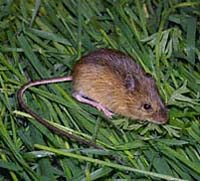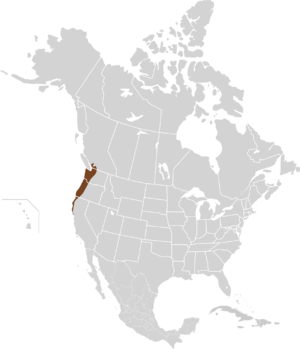Pacific jumping mouse facts for kids
Quick facts for kids Pacific jumping mouse |
|
|---|---|
 |
|
| Conservation status | |
| Scientific classification | |
| Genus: |
Zapus
|
| Species: |
trinotatus
|
 |
|
| Synonyms | |
|
Z. eureka A. B. Howell, 1920 |
|
The Pacific jumping mouse (Zapus trinotatus) is a small rodent known for its amazing jumping skills! These mice live in Canada and the United States. They prefer to live in wet places like grassy areas and swamps.
Contents
What Makes the Pacific Jumping Mouse Special?
Pacific jumping mice are bigger than other mice in their group. They have a clear color difference between their back and their belly. Their ears often have light brown fur, or fur that matches their back. This helps tell them apart from other jumping mice, like the Western jumping mouse.
These mice love damp places. You can often find them near streams or in meadows close to small rivers. They mostly eat grass seeds. Because of this, they like areas with lots of thick plants. These plants offer both food and a safe hiding spot from animals that might hunt them. Besides grass, they also munch on fungi and insects.
As autumn arrives, they eat a lot to get fat. This helps them get ready for hibernation in winter. They sleep in small burrows underground for up to 8 months! After waking up, they find a mate and have babies.
Where Do Pacific Jumping Mice Live?
Pacific jumping mice prefer to live in wet areas. This includes marshes with plants like alder trees, salmonberry bushes, and skunk-cabbage. They also like wet areas along rivers in redwood forests near the coast.
In northern places, they live in thick forests, wet grassy spots, and high-up meadows in the Cascade Mountains in Washington and the Olympic Peninsula. You might also find them in marshy bushes, at the edges of forests with lots of weeds and ferns, and in open meadows.
What Is Their Habitat Like?
The Pacific jumping mouse can live in many different wet places. This includes areas near streams, brushlands, lakes, forests, fields, swamps, meadows, shrubs, bogs, marshes, and along the banks of rivers and ponds. Their home range covers the whole Pacific Northwest, California, and western Canada.
What Do Pacific Jumping Mice Eat?
The diet of Pacific jumping mice includes fungi, insects, snails and slugs, wild fruits, seeds, and wild berries. They look for food on the ground. They can even cut down tall plants to reach the seeds! They sometimes cut grass and leave it in neat piles, but they don't store food for later.
Behavior of the Pacific Jumping Mouse
Baby Pacific jumping mice make loud, sharp squeals. Adult mice are amazing at escaping danger! They can leap over 150 centimeters (about 5 feet) in one jump. When they leap, they turn their head down, arch their back, and dive to the ground. This helps them get ready for another quick jump. They can also stay very still and rely on their fur to blend in with their surroundings, making them hard to spot.
These mice are most active from when the sun sets until it rises again. They grab their food with their front paws. They can be quite nervous and jumpy. If they get trapped, they might act aggressive. However, usually, they are gentle animals. When they fight, they make a squeaking noise and tap their tails on the ground, making a drumming sound. If they get upset, they jump and move around wildly.
To get ready for summer, Pacific jumping mice build a simple, dome-shaped nest. It usually has only one entrance and is built on the ground.
Reproduction and Life Cycle
Pacific jumping mice become old enough to have babies the year after they are born. Males and females are ready to mate in May or June. The mother mouse carries her babies for about 18 to 23 days. They usually give birth in July or August. Each group of babies, called a litter, has about 4 to 8 young. The babies drink their mother's milk for about 4 weeks.
When they are born, Pacific jumping mice are pink and have no hair. They weigh only about 0.7 to 0.9 grams (less than a paperclip!). Their eyes are closed, and they depend on their mother for the first few weeks. They become independent and can live on their own after about a month.


